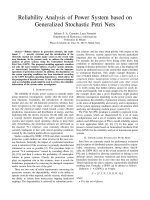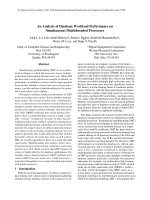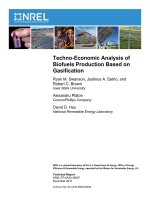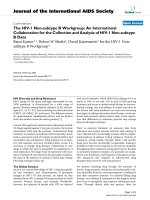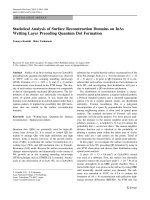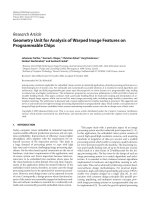Design and analysis of object replacement policies on dynamic data allocation and replication algorithm with buffer constraints
Bạn đang xem bản rút gọn của tài liệu. Xem và tải ngay bản đầy đủ của tài liệu tại đây (638.58 KB, 104 trang )
DESIGN AND ANALYSIS OF OBJECT
REPLACEMENT POLICES ON DYNAMIC DATA
ALLOCATION AND REPLICATION ALGORITHM
WITH BUFFER CONSTRAINTS
GU XIN
(B.Eng., Beijing University of Aeronautics and Astronautics, PRC )
A THESIS SUBMITTED
FOR THE DEGREE OF MASTER OF ENGINEERING
DEPARTMENT OF ELECTRICAL & COMPUTER ENGINEERING
NATIONAL UNIVERSITY OF SINGAPORE
2003
i
Acknowledgements
I would like to express my deepest gratitude to my supervisor, Assistant Processor Dr. Veeravali Bharadwaj. Without his insightful ideas, valuable suggestions and constant encouragement, I could not have accomplished my research work. I want to deliver my sincere esteem
to his rigorous research style, which led me to a correct research attitude. I am also very
grateful to my supervisor for his help during the time I were receiving medical treatments
in the hospital. Without his continuous and persistent support my research would not have
been possible.
My wholehearted thanks to my family for their endless encouragement and self-giving love
throughout my life. Deepest thanks to all my friends and lab mates in Open Source Software
Lab for their ideas and support. The friendship with them makes my study in NUS a pleasant
journey.
My special thanks to the National University of Singapore for granting me Research Scholarship and the Open Source Software Lab for providing an efficient working environment and
facilities.
Finally, I would like to thank all those who granted me directly and indirectly help during
the course of my research study with their inputs and support.
ii
Contents
List of Figures
v
List of Tables
vi
Summary
vii
1 Introduction
1
1.1
Related Work . . . . . . . . . . . . . . . . . . . . . . . . . . . . . . . . . . . .
3
1.2
Issues To Be Studied and Main Contributions . . . . . . . . . . . . . . . . . .
4
1.3
Organization of the Thesis . . . . . . . . . . . . . . . . . . . . . . . . . . . . .
7
2 System Modeling
8
2.1
Distributed Database Systems . . . . . . . . . . . . . . . . . . . . . . . . . . .
8
2.2
The Model . . . . . . . . . . . . . . . . . . . . . . . . . . . . . . . . . . . . . .
10
2.2.1
Request schedules and allocation schemes . . . . . . . . . . . . . . . . .
10
2.2.2
Cost model . . . . . . . . . . . . . . . . . . . . . . . . . . . . . . . . .
12
2.2.3
Definitions, terminologies and notations
. . . . . . . . . . . . . . . . .
15
Concluding Remarks . . . . . . . . . . . . . . . . . . . . . . . . . . . . . . . .
16
2.3
iii
3 Data Allocation and Replication with Finite-size Buffer Constraints
19
3.1
DWM Algorithm . . . . . . . . . . . . . . . . . . . . . . . . . . . . . . . . . .
20
3.2
Strategies To Deal With Object Replacement . . . . . . . . . . . . . . . . . .
24
3.2.1
Two models . . . . . . . . . . . . . . . . . . . . . . . . . . . . . . . . .
25
3.2.2
Object replacement algorithms
. . . . . . . . . . . . . . . . . . . . . .
26
Modified Cost Function . . . . . . . . . . . . . . . . . . . . . . . . . . . . . . .
31
3.3
4 Analysis of the Data Allocation Algorithm With Finite-size Buffers
4.1
4.2
4.3
37
Competitiveness . . . . . . . . . . . . . . . . . . . . . . . . . . . . . . . . . . .
38
4.1.1
Offline and online dynamic data allocation algorithms . . . . . . . . . .
38
4.1.2
The competitive ratio and competitiveness . . . . . . . . . . . . . . . .
39
Competitive Ratio of Different Strategies . . . . . . . . . . . . . . . . . . . . .
40
4.2.1
Competitive ratio of dynamic allocation DWM-No Replacement . . . .
40
4.2.2
Competitive ratio of dynamic allocation DWM-Replacement . . . . . .
54
4.2.3
Cost comparison analysis . . . . . . . . . . . . . . . . . . . . . . . . . .
68
Competitive Ratios of Different Strategies In Model B . . . . . . . . . . . . . .
70
5 Experimental Analysis of the Algorithms
74
5.1
Some Basic Views and Expectations on the Experiments . . . . . . . . . . . .
75
5.2
Simulation Results in Model A . . . . . . . . . . . . . . . . . . . . . . . . . . .
78
5.3
Simulation Results in Model B . . . . . . . . . . . . . . . . . . . . . . . . . . .
82
6 Conclusions and Future Work
86
iv
Bibliography
90
Appendix A: Author’s Papers
95
v
List of Figures
2.1
DDBS environment . . . . . . . . . . . . . . . . . . . . . . . . . . . . . . . . .
2.2
Different allocation scheme according to a write-request wji when server i ∈
9
F ∪ {p} and i ∈ F ∪ {p} . . . . . . . . . . . . . . . . . . . . . . . . . . . . . .
18
3.1
Concurrent control mechanism of CCU . . . . . . . . . . . . . . . . . . . . . .
21
3.2
DWM working style . . . . . . . . . . . . . . . . . . . . . . . . . . . . . . . . .
21
4.1
Superiority of DWM-Replacement . . . . . . . . . . . . . . . . . . . . . . . . .
69
4.2
Superiority of DWM-Replacement and DWM-No Replacement . . . . . . . . .
70
5.1
Cumulative cost under different total number of requests (write requests: 5%
and 10%) . . . . . . . . . . . . . . . . . . . . . . . . . . . . . . . . . . . . . .
5.2
Cumulative cost under different local database capacities (fixed total number
of requests of 50k and 100k respectively and write requests: 5%) . . . . . . . .
5.3
80
Cumulative cost under different total number of requests in Model B (write
requests: 5% and 10%) . . . . . . . . . . . . . . . . . . . . . . . . . . . . . . .
5.4
79
83
Cumulative cost under different local database capacities in Model B (fixed
total number of requests of 50k and 100k respectively and write request: 5%) .
84
vi
List of Tables
2.1
Glossary of definitions and notations . . . . . . . . . . . . . . . . . . . . . . .
18
3.1
Pseudo code of LRUhet algorithm . . . . . . . . . . . . . . . . . . . . . . . . .
30
3.2
Pseudo code of LFUhet algorithm . . . . . . . . . . . . . . . . . . . . . . . . .
31
5.1
Parameters for simulation given a fixed local database capacity . . . . . . . . .
78
5.2
Parameters for simulation given a fixed number of requests . . . . . . . . . . .
80
5.3
Parameters for simulation for heterogenous-sized objects given a fixed local
database capacity . . . . . . . . . . . . . . . . . . . . . . . . . . . . . . . . . .
5.4
83
Parameters for simulation for heterogenous-sized objects given a fixed number
of requests . . . . . . . . . . . . . . . . . . . . . . . . . . . . . . . . . . . . . .
84
vii
Summary
In the theoretical computer research areas, there has been lots of works on distributed database
system. As a part of research in the domain of distributed object management, the basic
idea underlying this thesis is to design efficient data allocation algorithms to minimize the
total servicing cost for an arbitrary request schedule which includes read requests and write
requests. In all works so far, however, the available resources at the single site or processor
are considered to be infinite. For example, the available local database buffer size to store
the replicas of the object at a site is assumed to be plentiful. However, in practice, each
processor has only a finite local database buffer capacity to hold the copies of the object.
When the available buffer space in a site is not enough to store a new copy of an object,
the decision has to be made by each processor, for example, to evict an object copy in use
to give space to the new copy. Thus we are naturally faced with a problem of allocating
and replicating the object with the consideration of local database buffer constraints. For
a distributed database system where each processor has only finite-size local database, we
analyze the allocation strategies with revised model of Dynamic Window Mechanism (DWM)
algorithm jointly implemented with three different types of object replacement strategies. If
optimal utilization of this distributed system is expected, it is suggested to apply an allocation
and replication algorithm to obtain the possible minimum cost for servicing the read-write
request schedule. For this goal, DWM is designed to dynamically alter the allocation scheme of
the object such that the cumulative cost of all operations involved in servicing read and write
viii
requests is minimized. Three different object replacement strategies work jointly with DWM
to deal with the situation wherein processors’ local database buffer size is limited. We will
show the impact on the allocation and replication strategies due to the limited local database
storage capacities. The performances of different algorithms are analyzed theoretically and
experimentally. We consider the competitive performance of different algorithms and present
algorithms with their competitive ratios. In a general sense, we consider the above mentioned
scenario in a model where the object sizes are assumed to be equal. We also consider the
situation in which the object sizes are different from each other. Thus we attack the problem
in a more generalized scenario.
1
Chapter 1
Introduction
Distributed database system (DDBS) technology is one of the major developments in the
database systems area. There are claims that in the near future centralized database management will be an “antique curiosity” and most organizations will move toward distributed
database management [1]. The intense interest in this subject in the research community
supports this claim. Distributed database management system (DBMS) thus play an increasingly important role and has attracted more and more research efforts since the last two
decades. The design of a distributed database management system involves making decisions
on the placement of data (object) and programs across the sites of a computer network. The
distribution of application programs is not a significant problem, since we assume that a copy
of the distributed DBMS software exists at each site where data is stored [2]. Therefore, extensive studies are concentrated on data(object) distribution problem, which is widely known
as data(object) allocation and replication problem.
In a distributed database, an object is usually desirable to be replicated in the local database
of multiple locations for performance, reliability and availability reasons [2, 9, 10]. The object
is accessed, i.e. read or written, from multiple distributed processors. These reads and writes
form a set of requests, which is usually serialized by some concurrency-control mechanism [11]
Chapter 1 Introduction
2
in order that each read request accesses the most recent version of the object(written by a
most recent write request). Such replication helps performance since diverse and conflicting
user requirements can be easily accommodated. For example, an object that is commonly
read by one processor can be placed on that processor’s local database. This increases the
locality of reference. Furthermore, if one of the processors fails, a copy of the object is still
available on another processor on the network. If we focus on the servicing cost of the set of
read-write requests for a replicated object, the cost of servicing a read or a write depends on
the allocation scheme of the object, which is a set of processors that store the most recent
version of the object in their local database. This is because that if a processor in the
allocation scheme of an object issues a read request for this object, the read will be serviced
locally and reading an object locally is less costly than reading it from a remote location.
On the other hand, the execution of a write request may cause trouble since it usually write
to all or a majority of copies of the object. Hence, the decision regarding data allocation
and replication is a trade-off which depends on the read-write pattern for each object. if the
read-write patterns change dynamically, in unpredictable ways, a dynamic allocation scheme
of an object is preferred since it changes as the read-write requests are serviced.
In addition, the data allocation and replication can be discussed in the larger context of
dynamic allocation. For example, the rapid growth of internet and World Wide Web is
moving us to a distributed, highly interconnected information system. In such systems, an
object (a document, an image, a file, raw data, etc.) is accessed from multiple distributed
locations. The allocation and replication of objects in such distributed system has crucial
effects on the system performance. Thus, all kinds of dynamic allocation problem can also
be performed by a large category, say Distributed Object Management (DOM) algorithms
[11]. A DOM algorithm maps each request to a set of processors to execute the request and
it determines the allocation scheme of the object upon the servicing of requests at any point
in time.
Chapter 1 Introduction
1.1
3
Related Work
Performance and reliability are the two major purposes of data allocation and replication. Our
work addresses the former. Traditional performance oriented works on data allocation consider
the static fashion, namely establishing an allocation scheme that will optimize performance,
but will remain fixed until manual reallocation is executed. It has been studied extensively
in the literature [40]. This problem is also called file allocation problem and the 1981 survey
paper by Dowdy and Foster [41], dealing with the file allocation problem, cites close to a
hundred reference. In contrast, our work keeps the allocation scheme dynamic during servicing
of the requests.
In the theoretical computer science community there has been work on online algorithms
[6], particularly for paging [42], searching [42] and caching [43]. Upon the analysis of online
algorithms, competitiveness and convergence are two criteria for evaluating online algorithms.
A competitive algorithm may not converge to the optimal allocation scheme when the readwrite pattern is fixed or stabilizes, but a convergent algorithm may unboundedly diverge from
the optimum when the read-write pattern is irregular. A competitive online algorithm is more
appropriate for chaotic read-write patterns in which the past access pattern does not provide
any indication to the future read-write pattern. In contrast, a convergent online algorithm is
more appropriate for regular read-write patterns. [6], [42] and [43] are some early works that
addressed competitiveness analysis for online algorithms. The work in this thesis also uses
competitive ratio to analyze the online algorithm.
The data allocation and replication algorithms developed in [13] are examples for convergence
rather than competitiveness. Assume that the pattern of access to each object is generally
regular. Then, the convergent algorithms will move to the optimal allocation scheme for
the global read-write pattern. The model there as well as in [14] and [17] considers only
communication and ignores the I/O cost and availability constraints. A different adaptive
Chapter 1 Introduction
4
data replication algorithm is developed in [12]. The algorithm, called ADR, is adaptive in
the sense that it changes allocation scheme of the object as changes occur in the read-write
pattern of the object. ADR is also a convergent algorithm. Both the algorithms in [13] and
[12] depend on the communication network having a specific tree topology.
A competitive dynamic data allocation and replication algorithm is presented in [17]. But this
algorithm ignores I/O cost and t-available constraint, which is a constraint that guarantees a
minimum number of copies of the object in the system at any point in time.
Another important competitive data allocation algorithm, called DA, is proposed in [11]. In
[11] a mathematical model that is suitable for stationary computing environment is introduced
for evaluating the performance of data allocation and replication algorithms in distributed
database. Authors studied dynamic allocation as an independent concept, unrestricted by
the limitations of a particular system, protocol, or application, and also considered caching
in a peer to peer rather than client-server environment. Competitive analysis was used to
establish significant relationship that indicates the superiority of static allocation and dynamic
allocation respectively.
Another research area that is relevant to my study in this thesis is caching management in
various contexts, e.g. internet and the World Wide Web, to quote some [29, 30, 31, 32, 33];
database disk buffering, e.g. [35, 36]; web proxy of World Wide Web, e.g. [37, 34]; and
Client/Server databases, e.g. [27, 28]. Related introduction and studies on concurrent control,
which is an essential module to account request serializability, were presented in [23, 24, 25].
1.2
Issues To Be Studied and Main Contributions
In the research area of data allocation and replication, a data allocation and replication
algorithm solves three fundamental questions: Which object should be replicated? How
Chapter 1 Introduction
5
many replicas of each object are created? Where should the replicas of an object be allocated?
Depending on different answers, different data allocation strategies are devised. In all works
so far in data allocation and replication, the available resources at the processing site of
distributed database system are always considered to be plentiful. For instance, the available
local database buffer size to store the replicas of each object is assumed to be infinite. However,
in reality, local database capacity at a processor is of finite size. When a processor’s local
database buffer is full while an allocation and replication scheme informs this processor of
the need to save a newly requested object in its local database, we are naturally confronted
with a problem of how to deal with this newly requested object. Should it be saved or not?
Where and how should it be saved? What kind of effects does it have on the running data
allocation algorithm? In this thesis, we consider the above mentioned scenario in which each
of the processors in the distributed database system has a local database of finite size.
In this thesis, we analyze the cost of servicing a set of read-write requests for a replicated object
and propose a mathematical model. With this mathematical model, the cost of servicing
a read or a write request depends on the allocation scheme of the object which is a set of
processors that store the most updated replicas of the object in their local databases. By using
this model, we design and analyze a dynamic data allocation algorithm that adapts to the
changes in the request patterns. This dynamic algorithm uses a windowing mechanism, and
hence, we refer to this scheme as dynamic window mechanism(DWM). The key idea of DWM
algorithm is to divide the read requests into saving-read requests and non-saving-read requests
based on whether this division is able to minimize the total cost of servicing all the requests in a
request sub-schedule. As an added constraint, our data allocation algorithm is working under
the situation wherein processors in distributed database have limited local database capacities,
which is reflective of a real-life situation. When a processor’s local database is full and
DWM decides that a new object for this processor should be replicated in its local database,
we propose three different strategies to tackle this problem. Strategy I is No Replacement
Chapter 1 Introduction
6
(NR). Both Strategy II, namely Least Recently Used (LRU), and Strategy III, namely Least
Frequently Used (LFU), will pick up and evict some existing objects in processor’s local
database buffer to give space for the new objet copy, thus these two strategies are put into one
category, namely DWM-Replacement, in our later theoretical analysis. The difference between
Strategy II and Strategy III is that they choose different evicting object candidate which has
least “bad” effects on the total servicing cost of all requests. With the implementation of three
strategies, we actually propose three versions of DWM based algorithms to attack dynamic
data allocation with buffer constraints, namely DWM-No Replacement (DWM-NR), DWMLeast Recently Used (DWM-LRU) and DWM-Least Frequently Used (DWM-LFU).
We use competitive analysis, which is a widely used analytical methodology to evaluate online
computation and online algorithms, to analyze and compare the performance of different
algorithms. By using this tool, we perform a worst-case comparison of an online algorithm
to an optimal, ideal, offline algorithm. By establishing cost functions for different strategies,
we not only obtain competitive ratios for different algorithms, but also show the superiorities
of different algorithms according to their competitiveness. We also use experimental analysis
to compare the performances of the proposed algorithms to each other. Rigorous simulation
experiments are carried out to validate the theoretical findings.
In a more general sense, we consider the above mentioned scenario in which the object sizes are
assumed to be equal. This is referred to as Model A (Homogenous Object Sizes) in our thesis.
We also consider the situation where the object sizes are different from each other. Thus we
attack the problem in a more generalized scenario. This situation is referred to as Model B
(Heterogenous Object Sizes). For Model B, besides Strategy I (No Replacement), we design
another two object replacement algorithms which are able to deal with the situation wherein
objects are of different sizes. The newly developed algorithms are logical extensions of LRU
and LFU. We denote them by Heterogeneous object sizes LRU(LRUhet ) and Heterogenous
object sizes LFU(LFUhet ). Accordingly, the DWM based algorithms used in Model B are
Chapter 1 Introduction
7
DWM-No Replacement (DWM-NR), DWM Heterogeneous object sizes LRU (DWM-LRUhet )
and DWM Heterogeneous object sizes LFU (DWM-LFUhet ).
1.3
Organization of the Thesis
The rest of the thesis is organized as follows:
In Chapter 2, we present the system model for data allocation and replication, we formalize
the cost function. In addition, some preliminary definitions and notations are introduced.
In Chapter 3, we investigate the data allocation problem with buffer constraints. We first
present the dynamic online algorithm, DWM. We also describe the object replacement strategies according to different environment models.
In Chapter 4, using competitive analysis, we state and prove competitive ratio of different
proposed strategies. Through cost comparison, we summarize the superiorities of different
strategies.
In Chapter 5, performances of the different proposed algorithms are studied using the simulation experiments. The observations are provided and useful discussion is also given in this
section.
In the last part, Section 6, we highlight the conclusion and give direction of our future work.
8
Chapter 2
System Modeling
In this chapter, we first introduce the concepts of distributed database system and distributed
database management system. Then, we describe the system model with discussions of its
components. In addition, definitions and notations that will be frequently used throughout
the thesis are introduced.
2.1
Distributed Database Systems
In recent years research and practical applications in the area of distributed systems have
developed rapidly, stimulated by the significant progress in two fields of computer science,
namely computer networks and database systems. Some of the most advanced types of
distributed systems are Distributed database systems (DDBS). Distributed database system
technology is one of the major developments in the database systems area. We can define a
distributed database as a collection of multiple, logically interrelated local databases distributed and interconnected by a computer network [2]. In both hardware and software aspects, a
DDBS may span many platforms, operating systems, communication protocols and database
architectures. A general DDBS is illustrated in Fig.2.1.
Chapter 2 System Modeling
9
Database
Processor
1
Processor
5
Processor
2
Communication
Network
Database
Processor
4
Processor
3
Database
Database
Figure 2.1: DDBS environment
A DDBS is managed by a Distributed Database Management System (DBMS). A DBMS is
defined as the software system that permits the management of the DDBS and gives the users
a transparent view of the distributed structure of the database [2]. New problem arises in
distributed database systems, in comparison with centralized database systems, in terms of
their management. One of the key problems is related to data allocation and replication. In
a distributed environment, physical distribution of data is a significant issue in that it creates
problems that are not encountered when the databases reside in the same computer. Data may
be replicated in distributed sites for reliability and efficiency considerations. Consequently, it
is responsible for a distributed database to have algorithms that analyze the request queries
and convert them into a series of data manipulation operations. The problem is how to
decide on a strategy for executing each request over the network in the most cost-effective
way. The factor to be considered are the distribution of data, communication costs , and
lack of sufficient locally available resources. The objective is to minimize the servicing cost
Chapter 2 System Modeling
10
and improve the performance of executing the transaction subject to the above-mentioned
constraints.
2.2
The Model
In this section, we first introduce our DDBS system and present the concept of request
schedules and allocation schemes. In addition, definitions and notations that will be frequently
used throughout the thesis are introduced. It is assumed that all the processors considered
here have only finite size local database storage buffer. We also formulate the basic cost
function on which our analysis of proposed algorithms is based on.
2.2.1
Request schedules and allocation schemes
In this thesis, our distributed database system consists of m processors, denoted by p1 , p2 , ..., pm ,
which is interconnected by a message passing network to provide inter-processors communications. The local database is a set of objects stored in local database buffer of a processor. We
assume that there is a Central Control Unit (CCU) in the system that knows the allocation
scheme of every object and every processor knows whether or not an object is available in its
local database buffer. Transactions operate on the object by issuing read and write requests.
Requests arrive at the system concurrently and there exits a Concurrent Control Mechanism
(CCM) to serialize them. A finite sequence of read-write requests of the object o, each of
which is issued by a processor, is called a request schedule. For example, ψo = r2 w4 r1 w3 r2
is a schedule for object o, in which the first request is a read request from processor 2, the
second request is a write request from processor 4, etc. In practice, any pair of writes, or a
read and a write, are totally ordered in a schedule; however, reads can execute concurrently.
Our analysis using the model applies almost verbatim even if reads between two consecutive
Chapter 2 System Modeling
11
writes are partially ordered.
In our system, we denote an allocation scheme as the set of processors that store the latest
version of the object in their local database. The allocation scheme of an object is either
dynamic or static, which means it either remains fixed or changes its composition as the
read-write requests are serviced. The initial allocation scheme is given by a set of processors
that have the object in their local database before the request schedule begins to be serviced.
At any point of time the allocation scheme at a request q for object o is a set of processors
that have the replica of object o in their local database right before q is executed, but after
the immediately-preceding request for o is serviced. We denote the initial allocation scheme
for object o as IAo and let Ao be the allocation scheme of object o at a request at any point
in time when the request schedule is executed. The initial allocation scheme IAo consists of a
set F of (t − 1) processors, and a processor p that is not in F . The processors of F are called
the main servers, and p is called the floating processor. The number of processors in F {p} is
t, which is referred to as t-availability constraint. Formally, t-availability constraint is defined
as, for some integer t which is greater than 1, the allocation scheme at every request is of size
which is at least t. In other words, t represents the minimum number of copies that must
exist in the system. For simplicity, we assume that t is at least two. We shall also assume
that t is smaller than the total number of processors in the network, otherwise, each new
version of the object created by a write request must be propagated to all the processors of
the network, and there is no need to address the problem with dynamic allocation algorithm.
When servicing the request schedule, each read request brings the object to main memory
of processor which issued this request in order to service this request. If this processor does
not have a copy of the object in its local database buffer, in case of dynamic allocation, the
reading processor, s, may also store the object in the local database in order to service future
reads at s locally. We denote a read request as a saving read which results in saving the object
in the local database. A read request which does not result in saving the object in the local
Chapter 2 System Modeling
12
database is denoted as a non-saving read request.
A write request in a schedule creates a new version of the object. Given a schedule, the latest
version of the object at a request q is the version created by the most recent write request
that proceeds q. The write request also sends the new version of object to all servers in F
and each server outputs the object into its local database. If the processor s which issued a
write request is a server in F , then s also sends a copy of the object to the floating processor
in order to satisfy the t-availability constraint. Additionally, the write request results in the
invalidation of the copies of the object at all other processors since these copies are obsolete.
We summarize the effect of a write by considering an allocation scheme A immediately after
a write request from a processor s. If s is in F , then A = F {p}, and if s is not in F , then
A = F {s}. The following example illustrates the execution of a request schedule and the
alteration of allocation scheme.
Example 2.1: Consider the request schedule ψo = r2 w4 r1 w3 r2 given above and the initial
allocation scheme {1, 2} in which 1 is the main server set F and 2 is the floating processor.
The allocation scheme at the first request r2 is {1,2}; the allocation scheme at the second
request w 4 is still {1,2} since processor 2 service the read request locally. The allocation
scheme at the third request is {1,4}, and the processor 4 enters the allocation scheme after a
write request (by processor 4) is serviced. The allocation scheme remains unchanged at the
forth request w 3 . Also, w3 makes processor 3 enter the allocation scheme, thus after finishing
the service of w3 , the allocation scheme at the last request r2 is {1,3}.
2.2.2
Cost model
In this section, we present the cost model widely used in analysis of object allocation and
replication in distributed database system. The performance matric in this thesis is the
cumulative cost of all the service behaviors related to handling read and write requests which
Chapter 2 System Modeling
13
arrive to the distributed database system. There are three types of costs associated with
servicing the access requests. The first one is the I/O cost, i.e., the cost of inputting the
object from the local database buffer to the processor’s main memory or outputting the object
from the processor’s main memory to the local database. The I/O cost of servicing an access
request is denoted by Cio . This means that the average I/O cost of a read or a write in the
distributed system is Cio . The other two types of costs are related to the communication cost
in the interconnected network, namely, the passing of control-messages and data-messages.
An example of a control-message is a request message issued by a processor p to request
another processor q to transfer a copy of an object which is not in p’s local database to
p. The data-message is merely a message in which the object is transmitted between the
processors via networks. Different costs are associated with the two types of messages. We
denote the communication cost of a control-message by Cc and the communication cost of a
data-message by Cd .
In addition, there is another kind of cost which comes from object invalidation operation.
This operation intends to invalidate the copies of an object o. Since the purpose of this
invalidation operation is to inform the certain processor to invalidate the corresponding object,
only control messages need to be passed. Thus, the cost of invalidation operation is equal to
Cc . As the fact that the size of a control-message is much shorter than a data-message since a
control-message consists of an object-id and operation types (read, write or invalidate) while
a data-message also includes the copy of object besides the object-id and operation types,
and the fact that the I/O operation is a local behavior which does not utilize any external
resources, it is reasonable to assume Cd ≥ Cc ≥ Cio . It may be noted that a control message
and an invalidation message are issued by the CCU unit. Additionally, observe that this
definition assumes a homogeneous system in which the data-message between every pair of
processors costs Cd , the control-message between every pair of processors costs Cc , and the
I/O cost is identical at all processors.
Chapter 2 System Modeling
14
In the existing literature [11, 17], without loss of generality, the I/O cost is normalized to
be one unit (Cio = 1). This means that Cc is the ratio of the cost of transmitting a control
message to the I/O cost of a read-write request. Similarly, Cd is the ratio of the cost of
transmitting a data message to the I/O cost of a read-write request. We now present the
model for computing the cost of servicing a read and a write request respectively. We denote
by COSTALG (q) the cost of servicing a request q with an algorithm ALG. Given a request
schedule ψo , the cost of servicing a request q, either a read or a write, is defined as follows:
Case A (Read request): Consider the request q as a read request ropi from processor pi for
object o and let Ao be the allocation scheme of object o at this request. Then,
1
COSTALG (ropi ) = 1 + Cc + Cd
2 + Cc + Cd
if pi ∈ Ao
if pi ∈ Ao and ropi is not a saving-read
(2.1)
if pi ∈ Ao and ropi is a saving-read
In Equation (2.1), if pi ∈ Ao , for a read request q, object o is simply retrieved from pi ’s local
database. Otherwise, besides the I/O cost at the processor which outputs the object from its
local database buffer, there is one Cc needed which is the cost of submitting a control message request to the server from CCU and one Cd needed which is the cost of transmitting the
object from the server in Ao to processor pi . From the above model, the only cost difference
between a saving-read request and a non-saving-read request is one I/O cost. This is because
a saving-read request need to save the object in the local database after the object is delivered
to processor pi .
Case B (Write request): Suppose that the request q is a write request wopi and let Ao
be the allocation scheme of object o at this request. Also, let Ao be the allocation scheme
Chapter 2 System Modeling
15
of object o after servicing this request. Note that Ao contains t processors according to the
t-availability constraint. Then, the cost of servicing this request is given by,
COSTALG (wopi ) = |Ao /Ao | · Cc + (|Ao | − 1) · Cd + |Ao |
(2.2)
The explanation for the write cost is as follows. Each of write request creates a new version
of object o. In order to keep the consistency of the object, an invalidate control message has
to be sent to all the processor of (Ao /Ao ), at which the copies of the object o are obsolete.
These processors are the processors of Ao (the old allocation scheme) that are not in Ao (the
allocation scheme after servicing this write request). Thus, this is the first term in the writecost equation. The next part (|Ao | − 1) · Cd is the cost of transferring the new copy of object
from processor pi to all the processors in new allocation scheme Ao except pi . The last part
accounts for the I/O cost when processors in Ao save the object into their local database.
Fig.2.2 shows different allocation schemes of object j after serving the write request wji in two
situations, i ∈ F ∪ {p} and i ∈ F ∪ {p}.
For the whole request schedule ψo = o1 o2 ...on and an initial allocation scheme IAo , where oi
is either a read or a saving-read, or a write request, we define the cost of the request schedule
ψo , denoted by COST (IAo , ψo ), to be the sum of all costs of the read-write requests in the
schedule, i.e.,
n
COST (IAo , ψo ) =
COST (oi )
(2.3)
i=1
2.2.3
Definitions, terminologies and notations
In this section, we present some preliminary definitions and notations based on the introduction above. These definitions and notations will be used frequently throughout this thesis.
Chapter 2 System Modeling
16
Table 2.1 presents a glossary of these frequently used definitions and notations.
2.3
Concluding Remarks
In this chapter, we introduced distributed database systems and some concepts widely used
in data allocation and replication in distributed database. We also introduced the basic cost
computation model that is adopted in the Distributed Object Management literature. Some
important notations and definitions that will be used frequently in the rest of the thesis were
introduced.

